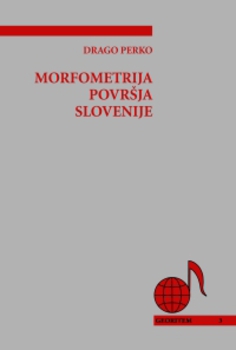Morfometrija površja Slovenije
This book describes some basic morphometric characteristics of Slovenia’s surface relative to its landscape types using a geographic information system and digital elevation model. The book compares the more recent 25-meter digital elevation model and the older 100-meter digital elevation model. Statistical analysis of the two digital elevation models of Slovenia indicates that the smallest differences exist relative to surface heights, that there are larger differences relative to surface aspects, and that the largest differences exist relative to surface slopes.
A digital elevation model makes it possible to determine surface distance, surface inclination, and surface curvature with regard to a horizontal or vertical plane in space. Variation of surface distance, surface inclination, and surface curvature over space (also called surface roughness) can be determined by local and regional surface roughness coefficients. The local coefficients are derived from the variability of the main cell and average of its neighboring cells, whereas the regional coefficients are derived from the variability of the main cell and average of all cells. The most applicable coefficients are the regional height, slope, and aspect coefficients of surface roughness.
The regional height coefficient (the relation between the standard deviation of the vertical distance of the cell (11 by 11 matrix or window) and the average vertical distance of all cells multiplied by 100) determines the spatial variability of height for all 32,436,672 cells of Slovenia’s 25-meter digital elevation model. The highest coefficients are found for Alpine mountains, followed by Alpine hills, Dinaric plateaus, and Mediterranean low hills. The lowest coefficients are found for Pannonian plains, followed by Alpine plains, Dinaric plains, and Mediterranean plateaus.
The regional slope coefficient (the relation between the standard deviation of the vertical inclination of the cell and the average vertical inclination of all cells multiplied by 100) determines the spatial variability of slope. The highest coefficients are found for Alpine mountains, followed by Alpine hills, Dinaric plateaus, and Mediterranean low hills. The lowest coefficients are found for Pannonian plains, followed by Alpine plains, Dinaric plains and Mediterranean plateaus.
The regional aspect coefficient (the relation between the standard deviation of the horizontal inclination of the cell and the average horizontal inclination of all cells multiplied by 100) determines the spatial variability of aspect. The highest coefficients are found for Pannonian plains, followed by Dinaric plains, Alpine plains, and Pannonian low hills. The lowest coefficients are found for Alpine mountains, followed by Dinaric plateaus, Alpine hills, and Mediterranean plateaus.
The regional joint coefficient (the geometric average of the regional slope coefficient and the regional aspect coefficient) determines the spatial variability of slope and aspect simultaneously. The highest coefficients are found for Alpine hills, followed by Alpine mountains, Dinaric plateaus, and Mediterranean low hills. The lowest coefficients are found for Pannonian plains, followed by Alpine plains, Dinaric plains, and Mediterranean plateaus.
Downloads

Series
License

This work is licensed under a Creative Commons Attribution-NonCommercial-NoDerivatives 4.0 International License.
